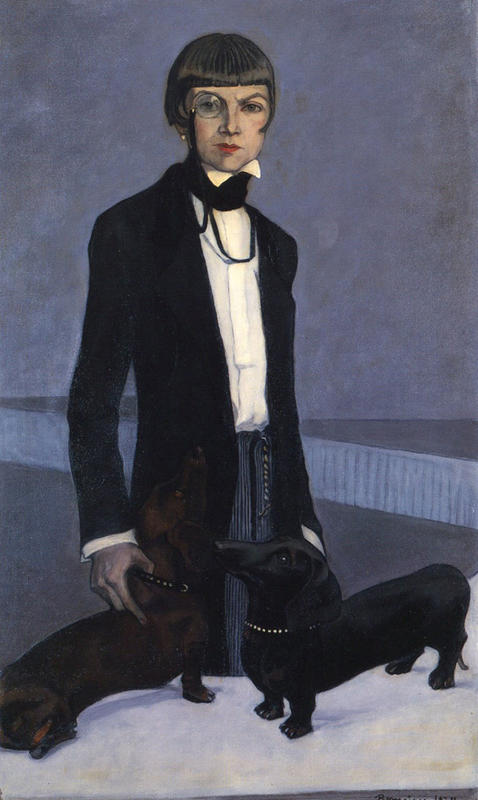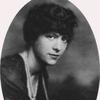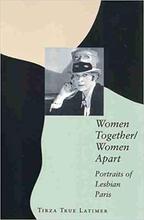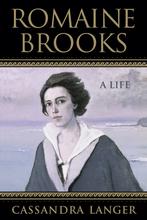More about Una, Lady Troubridge
- All
- Info
- Shop

Contributor
Behind Una, Lady Troubridge lies two stories about two remarkable women who led surprisingly parallel lives.
This painting by American artist, Romaine Brooks, marks an important point in feminist history. Try and picture what you think women of the 1920s looked like. Let me guess, you’re probably conjuring up some Great Gatsby-esque drunken dream of women in sparkly, sequined flapper dresses with ringlet curls and dramatic makeup. Women who knew how to have a good time but ultimately were at the beck and call of their overbearing husbands, much like Daisy Buchanan. However, this is only a snippet of what the female population was like in the ‘20s.
Not to say women like Romaine Brooks and Lady Troubridge didn’t know how to party; trust me, they did. However, more than that, they represent a generation of women in the 20s that broke the female stereotype: they were freethinking, living on their own, becoming renowned and respected figures, creating their own intellectual societies. They were constantly testing social constrictions: openly entering into homosexual relationships, trying their hands at jobs that were traditionally reserved for men, and dressing androgynously like Lady Troubridge’s outfit above.
Beyond having similar fashion taste, Romaine Brooks and Lady Una Troubridge were two women cut from the same cloth (fashion pun intended) in many respects. While the two were born on opposite sides of the Atlantic Ocean, the former American and the latter British, they had similar rocky childhoods. They both had violent, abusive mothers and absent fathers. Brooks was able to escape her tumultuous family life by going to study art abroad. Troubridge also turned to the arts becoming a renowned sculptor and a sought-after translator for both French and Italian. Both married men, but only for short periods of time before they left their husbands for female lovers.
Lady Troubridge left her husband, Captain Ernest Troubridge, for the love of her life, writer Radclyffe Hall, who is the author of the famous lesbian novel, The Well of Loneliness. Meanwhile, Brooks fell in love with the American writer, Natalie Clifford Barney. However, Barney was already in a long-term relationship with a Parisian aristocrat, Elisabeth de Gramont. Surprisingly, rather than sever either relationship, the three entered into a polyamorous relationship which lasted for the rest of their happy lesbian lives. Can you imagine if this was the solution to all love triangles? A majority of the romance genre would be out the window! No more Edward vs. Jacob or Darcy vs. Wickham. All jokes aside, this situation worked exceedingly well for them. Gramont commented on their relationship, which was based on equality and encouraged sexual freedom, saying that “civilized beings are those who know how to take more from life than others.”
One famous, polyamorous lesbian relationship that was open in the 1920s might surprise some readers, then brace yourself because Lady Una Troubridge entered into almost the exact same situation. Troubridge entered into a “close” friendship with the feminist writer, Radclyffe Hall, the same year that she divorced her husband (coincidence I think not). Eventually, Troubridge also entered into a polyamorous relationship; although, not as eagerly as Brooks. After being together for nearly two decades, Hall became infatuated with a Russian nurse named Evgenia Souline. Despite Troubridge’s jealousy and dissatisfaction, she reluctantly entered into a three-way relationship until Hall’s death in 1943.
So how did these two women, who lived such parallel lives and arguably looked quite similar, end up knowing each other well enough for Troubridge to become the subject of one of Brooks’ paintings? Well, remember Natalie Barney, part of the Brooks trio? Part of her claim to fame was creating a thriving intellectual society for some of the brightest and most forward-thinking women in Paris at the time. It was there that Brooks and Troubridge became acquainted, never knowing how similarly their lives would play out.
Sources
- http://www.lesbiannews.com/elisabeth-de-gramont-romaine-brooks/
- https://www.azquotes.com/author/6136-Radclyffe_Hall
- https://en.wikipedia.org/wiki/Radclyffe_Hall
- https://en.wikipedia.org/wiki/Romaine_Brooks
- https://americanart.si.edu/artwork/una-lady-troubridge-2926
- https://en.wikipedia.org/wiki/Una_Vincenzo,_Lady_Troubridge













